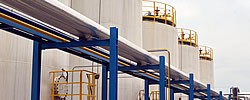Lubricant demand in China has jumped so much in recent years that some now deem it the world’s biggest market, surpassing the United States. The country’s demand for polyalphaolefins, however, remains scant.
But limited existing demand for PAO has not prevented Chinese players from lining up to supply the market. Two companies – Naco Lubrication Co. Ltd. and Shanghai Fox – now operate plants that supply PAO for local lubricant blenders, and Naco is building a third production facility. Like international competitors that have established a presence, both companies say they are banking on demand increase in coming years.
Naco Synthetics opened its first plant, located near its headquarters in Shanghai, last October. The facility has capacity to manufacture 15,000 metric tons per year of high-viscosity PAOs that it markets under the brand SinoSyn.
In Shanxi province, Naco established a joint venture with Chinese coal mining company Lu An Group. The Shanxi facility, which is under construction and scheduled to start operations in September, will use coal-to-liquids feedstock to manufacture high-viscosity PAOs for synthetic lubricants and have the same capacity as the Shanghai plant.
Naco, which started distributing lubricant materials such as polyisobutylene through China in 1998, believes there is significant potential for growth in PAO demand in China – more than in mature markets such as Japan, South Korea, Australia and the U.S.
“High-viscosity PAOs in China are mostly used by foreign companies, as Chinese companies are still trying to get to know the product,” Liu Qingcai, Naco’s marketing director, told Lube Report Asia. “However, the growing demand in China for high quality lubes provides great opportunities for local PAO suppliers because multinationals are trying to localize their PAO supply chain to lower costs.”
He added that low-viscosity PAOs, which are largely used in vehicles, will also be in demand, especially with the introduction of new engine oil specifications – PC-11 for heavy-duty diesel vehicles and GF-6 for passenger cars – by the American Petroleum Institute and the International Lubricants Standardization and Approval Committee (ILSAC). Both PC-11 and GF-6 put focus on fuel economy, which could be benefited from low-viscosity lubes.
Late last year, ExxonMobil officials said PAOs have a bright future in China and the rest of Asia because the region will need synthetic base stocks to help conserve energy as consumption swells the next couple decades.
ExxonMobil and other international PAO suppliers already offer them in China, but observers say demand has been slow to take off. Some predict that the current glut of Group II and III base stocks will continue to retard growth because it means cheap alternatives to PAOs for some applications.
“Light-viscosity PAOs are facing fierce competition with lower-priced API Group II and III base stocks, as well as gas-to-liquid base oils,” Liu said. “That’s why our recent focus is all on high-viscosity PAOs,” He added. However, “Low-vis PAOs’ advantage, especially in hydraulic oils, cannot be replaced by API Group II and III base oils. We see demand growing stably,” Liu said.
Naco’s rival, Shanghai Fox Chemical Technology Ltd., has a broader strategy. Under the brand name FoxSyn, it produces proprietary low-viscosity and high-viscosity PAOs, as well as metallocene polyalphaolefins (mPAOs) at a plant in Nanjing.
About a year ago, the company started to produce synthetic engine lubes with the brand name Long Yao using its own PAOs. It also set up an online store and opened regional service centers. Li Shaorong, Fox’s general manager, told Chinese media that his goal is to “produce products to beat multinationals in terms of quality and prices.”



